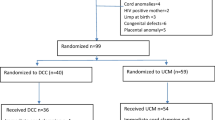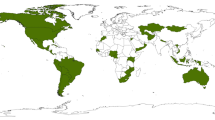Abstract
The aim of the study was to provide accurate information regarding live-born infant survival after diagnosis of fatal fetal anomaly (FFA) to aid decision-making in respect of pregnancy management, and to ascertain the natural history of live-born infants with FFAs via a retrospective analysis of death records (2006–2018), from the National Paediatric Mortality Registry (source Central Statistics Office 2019). Diagnoses and survival times were ascertained from narrative records with further ascertainment and reconciliation of trisomies 13 and 18 cases by review of cytogenetic test records, the National Death Events Register and National Perinatal Epidemiology Centre data. During the study period, termination of pregnancy was not permitted under the Irish Constitution. Patients are live-born babies with fatal fetal anomalies whose deaths were registered in the Republic of Ireland. The main outcome measure was construction of anomaly-specific survival curves, or survival time range and median for those anomalies with rare occurrence. Survival curves for anencephaly, bilateral renal agenesis, thanatophoric dysplasia, trisomy 13, and trisomy 18 show that 90% (n = 95), 93% (n = 60), 100% (n = 14), 37% (n = 92) and 33% (n = 162), respectively, were deceased by 24 h and 98%, 100%, 100%, 73%, and 53%, respectively, by 1 week post-delivery. Survival time range and median were calculated for triploidy (3.5 h–20 days; 10.5 days), whose occurrence was rare. Anhydramnios, craniorachischisis, hydranencephaly and severe hydrocephalus were extremely rare and all deaths were neonatal deaths. Our results provide 13 years of national natural history data of live birth FFA survival. This provides objective information to aid obstetric counselling of couples upon diagnosis of an FFA.



Similar content being viewed by others
Data availability
Original data is not available as it captures rare patient events that might be identifiable despite being anonymised.
References
Barry SC, Walsh CA, Burke AL, McParland P, McAuliffe FM, Morrison JJ (2015) Natural history of fetal trisomy 13 after prenatal diagnosis. Am J Med Genet A 167A:147–150
Boland R (2016) Caring for our disabled daughter: I fear for our marriage. https://www.irishtimes.com/life-and-style/health-family/caring-for-our-disabled-daughter-i-fear-for-our-marriage-1.2880564. Accessed October 2020
Burke AL, Field K, Morrison J (2013) Natural history of fetal trisomy 18 after prenatal diagnosis. Arch Dis Child Fetal Neonatal Ed 98:F152–F154
Cavadino A, Morris JK (2017) Revised estimates of the risk of fetal loss following a prenatal diagnosis of trisomy 13 or trisomy 18. Am J Med Genet 173:953–958
Central Statistics Office https://www.cso.ie. Accessed May 2019)
Department of Health, Social Services and Public Safety (2016) Guidance for HSC professionals on termination of pregnancy in Northern Ireland, March 2016. https://www.health-ni.gov.uk/publications/guidance-hsc-professionals-termination-pregnancy-northern-ireland. Accessed March 2020
Embleton ND, Wyllie JP, Wright MJ, Burn J, Hunter S (1996) Natural history of trisomy 18. Arch Dis Child 75:F38–F41
Hayes-Ryan D, McNamara K, Russell N et al (2017) Maternity ultrasound in the Republic of Ireland 2016: a review. Irish Med J 110(7). https://www.lenus.ie/handle/10147/622508. Accessed January 2020
Houlihan OA, O’Donoghue K (2013) The natural history of pregnancies with a diagnosis of trisomy 18 or trisomy 13; a retrospective case series. BMC Pregnancy Childbirth 13:209. https://doi.org/10.1186/1471-2393-13-209
Irish National Paediatric Mortality Registry: Available on https://www.hiqa.ie/areas-we-work/health-information/data-collections/national-paediatric-mortality-register. Accessed January 2020
Lefter S, Hardiman O, Ryan A (2014) Methodology and design of a national epidemiological study on adult neuromuscular disease. Methods Neuroepidemiol 43:123–130. https://doi.org/10.1159/000367634
McCarthy CM, O’Donoghue K (2014) Conjoined twins: experience in an Irish tertiary centre. J Obstet Gynaecol 34(3):225–228. https://doi.org/10.3109/01443615.2013.835305
Meyer ER, Liu G, Gilboa S, Ethen MK et al (2015) Survival of children with trisomy 13 and trisomy 18: a multi-state population based study. Am J Med Genet A 170A:825–837
Murphy NC, Dunne H, Flood K (2020) Prenatally diagnosed fetal aneuploidy: natural history and subsequent management. Ir Med J 113(3):34–40
National Paediatric Epidemiology Centre. https://www.ucc.ie/en/npec/. Accessed February 2020
Nguyen JE, Salemi JL, Tanner JP, Kirby RS et al (2018) Survival and healthcare utilization of infants diagnosed with lethal congenital malformations. J Perinatol 38:1674–1684
Obeidi N, Russell N, Higgins JR, O’Donoghue K (2010) The natural history of anencephaly. Prenat Diagn 30(4):357–360. https://doi.org/10.1002/pd.2490
O’Donoghue K (2019) Pathway for management of fatal fetal anomalies and/or life-limiting conditions diagnosed during pregnancy – perinatal palliative care http://52.164.250.231/eng/about/who/acute-hospitals-division/woman-infants/bereavement-care/pathway-for-perinatal-palliative-care.pdf. Accessed March 2020
Pergament E, Pergament D (2012) Reproductive decisions after fetal genetic counselling. Best Pract Res Clin ObGyn 26:517–529
Power S, Meaney S, O’Donoghue K (2021) Fetal medicine specialist experiences of providing a new service of termination of pregnancy for fatal fetal anomaly: a qualitative study. BJOG 128(4):676–684. https://doi.org/10.1111/1471-0528.16502
Royal College of Physicians of Ireland (2019) Interim clinical guidance on pathway for management of fatal fetal anomalies and/or life-limiting conditions during pregnancy: termination of pregnancy, January 2019. https://rcpi-live-cdn.s3.amazonaws.com/wp-content/uploads/2019/01/IOG-TOPFA-PATHWAY-FINAL-180119.pdf. Accessed November 2019
Sawai H, Oka K, Ushioda M et al (2019) National survey of prevalence and prognosis of thanatophoric dysplasia in Japan. Peds Internat 61:748–753
UK Public General Acts (2019) Northern Ireland (Executive Formation etc) Act 2019. https://www.legislation.gov.uk/ukpga/2019/22/enacted. Accessed October 2020
Vendola C, Canfield M, Daiger SP et al (2010) Survival of Texan infants born with trisomies 21, 18 and 13. Am J Med Genet A 152A:360–366
Wilkinson D, Thiele P, Watkins A, De Crespigny L (2012) Fatally flawed? A review and ethical analysis of lethal congenital malformations. British J Obs Gyn 119:1302–1308
Wylie JP, Wright J, Burn J, Hunter S (1994) Natural history of trisomy 13. Arch Dis Child 71:343–345
Acknowledgements
We would like to thank Dr. Jan Miletan, Dr. Breda Hayes, Dr. Niamh Ni Shuibne, Mr. Paul Corcoran, Ms. Mary Cunniffe and Ms. Rita Kavanagh for their help in this study. We thank the patients and staff of the maternity units in Ireland who have contributed to the National Perinatal Epidemiology Centre. We are grateful to the individual units for their participation in the NPEC national clinical audits and the data coordinators at unit level who facilitate data submission. We thank the NPEC, the NPEC Governance Committee and the NPEC Perinatal Mortality Group which facilitate this work.
Funding
This study was part of a larger study for which we received grant support (RPAC 17–06) from the Temple Street Foundation, Dublin, Ireland. The funder had no role in the study design, execution, analysis or manuscript preparation. The research was undertaken at Temple Street Children’s University Hospital, Dublin.
Author information
Authors and Affiliations
Contributions
All authors made substantial contributions to this work.
EAG: study design, data collection, interpretation and analysis and manuscript preparation.
SAL: study design, data interpretation and analysis and manuscript preparation.
CMcG: data collection and manuscript preparation.
KH: data collection and manuscript preparation.
DML: study design, data interpretation and analysis and manuscript preparation.
Corresponding author
Ethics declarations
Ethics approval
Permission for this project was obtained as a health researcher in adherence with the Statistics Act, 1993, which allows access to more detailed vital statistics to those engaged in medical or social research.
Conflict of interest
Emer Gunne, Sally Ann Lynch, Cliona McGarvey, Karina Hamilton and Deborah Lambert have no competing interests to declare. ‘Results are based on analysis of strictly controlled Research Microdata Files provided by the Central Statistics Office (CSO). The CSO does not take any responsibility for the views expressed or the outputs generated from this research’.
Additional information
Publisher’s note
Springer Nature remains neutral with regard to jurisdictional claims in published maps and institutional affiliations.
Rights and permissions
About this article
Cite this article
Gunne, E., Lynch, S.A., McGarvey, C. et al. Fatal fetal abnormality Irish live-born survival—an observational study. J Community Genet 12, 643–651 (2021). https://doi.org/10.1007/s12687-021-00534-3
Received:
Accepted:
Published:
Issue Date:
DOI: https://doi.org/10.1007/s12687-021-00534-3




